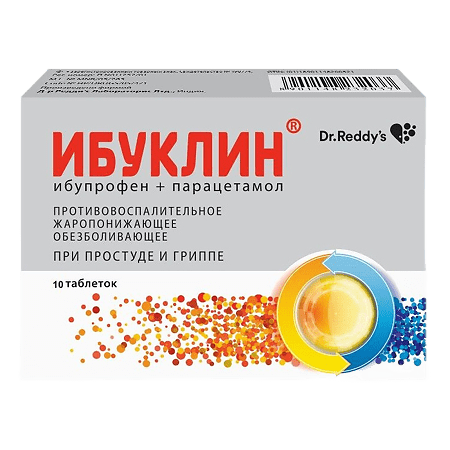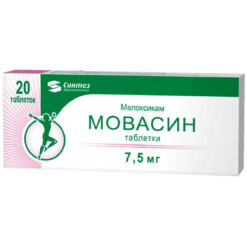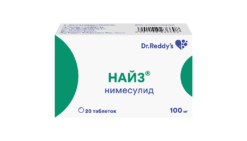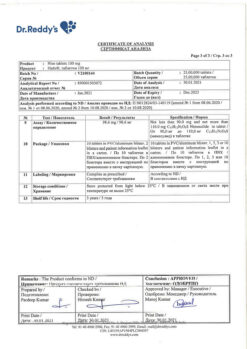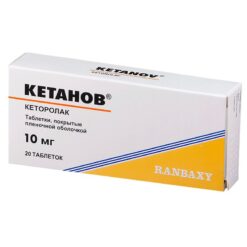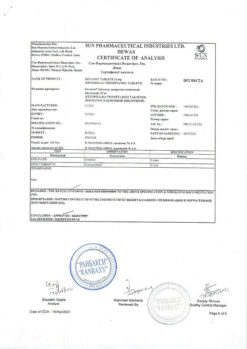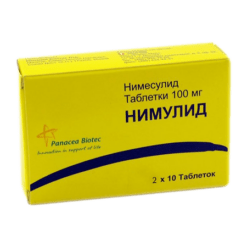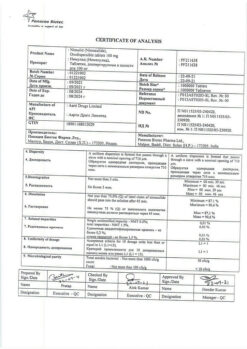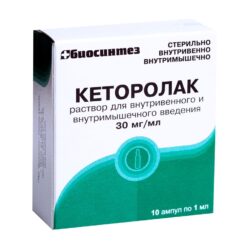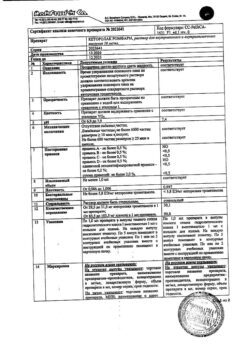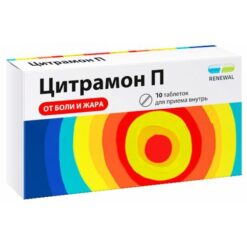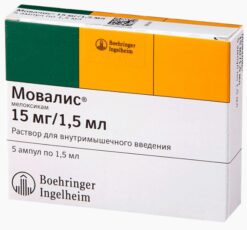No products in the cart.
Ibuklin, 400 mg+325 mg 10 pcs
€6.02 €5.35
Description
Joint pain (arthralgia), Painful menstruation (algodysmenorrhea), Fever, Toothache, Myalgia (muscle pain), Headache, Bruises, Neuralgia, Acute respiratory infections
- .Symptomatic therapy of infectious and inflammatory diseases (colds, flu) accompanied by fever, chills, headache, pain in muscles and joints, sore throat;
- .Myalgia,
- neuralgia,
- backache,
- joint pain, pain syndrome of inflammatory and degenerative diseases of the musculoskeletal system
- pain
- post-traumatic and postoperative pain syndrome;
- dental pain;
- aldysmenorrhea (painful menstruation).
pain at bruises, sprains, dislocations, fractures;
The drug is intended for symptomatic therapy, reducing pain and inflammation at the time of use, does not affect the progression of the disease.
Indications
Indications
Symptomatic treatment of infectious and inflammatory diseases (colds, flu), accompanied by fever, chills, headache, muscle and joint pain, sore throat;
myalgia;
neuralgia;
back pain;
joint pain, pain syndrome in inflammatory and degenerative diseases of the musculoskeletal system;
pain from bruises, sprains, dislocations, fractures;
post-traumatic and postoperative pain syndrome;
toothache;
algodismenorrhea (painful menstruation).
The drug is intended for symptomatic therapy, reducing pain and inflammation at the time of use, does not affect the progression of the disease.
Pharmacological effect
Pharmacological effect
Pharmacodynamics
Special instructions
Special instructions
It is recommended to take the drug in the shortest possible short course and in the minimum effective dose necessary to eliminate symptoms.
In patients with bronchial asthma or allergic diseases in the acute stage, as well as in patients with a history of bronchial asthma/allergic diseases, the drug may provoke bronchospasm.
Active ingredient
Active ingredient
Ibuprofen, Paracetamol
Composition
Composition
Each film-coated tablet contains:
Pregnancy
Pregnancy
In the first and second trimesters of pregnancy, the use of Ibuklin® is possible only as prescribed by a doctor in cases where the potential benefit outweighs the possible risk to the mother and the potential risk to the fetus. The use of the drug in the third trimester of pregnancy is contraindicated.
If it is necessary to use the drug during breastfeeding, breastfeeding should be stopped.
Contraindications
Contraindications
Increased individual sensitivity to the components of the drug (including other NSAIDs).
Erosive and ulcerative diseases of the gastrointestinal tract (including gastric and duodenal ulcers, Crohn’s disease, ulcerative colitis) or ulcerative bleeding in the active phase or in history (two or more confirmed episodes of peptic ulcer or ulcerative bleeding).
Cerebrovascular or other bleeding.
Hemophilia or other bleeding disorders (including hypocoagulation), hemorrhagic diathesis, intracranial hemorrhage.
Severe renal failure (creatinine clearance (CC) less than 30 ml/min).
Complete or incomplete combination of bronchial asthma, recurrent polyposis of the nose and paranasal sinuses, and intolerance to acetylsalicylic acid or other NSAIDs (including a history).
Severe heart failure (class IV according to the New York Heart Association NYHA classification).
Decompensated heart failure.
Optic nerve lesions.
Genetic absence of glucose-6-phosphate dehydrogenase.
Diseases of the blood system.
The period after coronary artery bypass surgery.
Progressive kidney diseases.
Severe liver failure or active liver disease.
Confirmed hyperkalemia.
Pregnancy (III trimester).
Children under 18 years of age.
With caution:
Coronary heart disease, chronic heart failure, peripheral arterial disease, arterial hypertension, blood diseases of unknown etiology (leukopenia and anemia), cerebrovascular diseases, dyslipidemia / hyperlipidemia.
A history of a single episode of gastric and duodenal ulcers or ulcerative bleeding of the gastrointestinal tract, a history of Helicobacter pylori infection, gastritis, enteritis, colitis, ulcerative colitis.
Viral hepatitis, moderate and mild liver failure, benign hyperbilirubinemia (Gilbert, Dubin-Johnson and Rotor syndrome), liver cirrhosis with portal hypertension.
Renal failure, including dehydration (creatinine clearance less than 30-60 ml/min), nephrotic syndrome.
Bronchial asthma or allergic diseases in the acute stage or in history – bronchospasm may develop.
Systemic lupus erythematosus or mixed connective tissue disease (Sharp’s syndrome) – increased risk of aseptic meningitis.
Chickenpox, severe somatic diseases, diabetes mellitus.
Concomitant use of other NSAIDs, oral glucocorticosteroids (including prednisolone), anticoagulants (including warfarin), antiplatelet agents (including acetylsalicylic acid, clopidogrel), selective serotonin reuptake inhibitors (including citalopram, fluoxetine, paroxetine, sertraline).
Old age, smoking, alcoholism.
Pregnancy I-II trimester, breastfeeding period.
Side Effects
Side Effects
Gastrointestinal disorders
Interaction
Interaction
When taken simultaneously with acetylsalicylic acid, ibuprofen reduces its anti-inflammatory and antiaggregation effect (an increase in the incidence of acute coronary insufficiency in patients receiving small doses of acetylsalicylic acid as an antiaggregation agent is possible after starting ibuprofen).
Combination with ethanol, corticosteroids, and corticotropin increases the risk of erosive and ulcerative lesions of the gastrointestinal tract.
Ibuprofen enhances the effect of direct (heparin) and indirect (coumarin and indanedione derivatives) anticoagulants, thrombolytic agents (alteplase, anistreplase, streptokinase, urokinase), antiplatelet agents, colchicine – the risk of developing hemorrhagic complications increases.
Strengthens the hypoglycemic effect of insulin and oral hypoglycemic drugs.
Weakens the effects of antihypertensive drugs and diuretics (due to inhibition of renal PG synthesis).
Increases the blood concentration of digoxin, lithium and methotrexate.
Caffeine enhances the analgesic effect of ibuprofen.
Cyclosporine and gold preparations increase nephrotoxicity.
Cefamandole, cefoperazone, cefotetan, valproic acid, plicamycin increase the incidence of hypoprothrombinemia.
Antacids and cholestyramine reduce the absorption of the drug.
Myelotoxic drugs contribute to the manifestation of hematotoxicity of the drug.
Overdose
Overdose
Symptoms: gastrointestinal disorders (diarrhea, nausea, vomiting, anorexia, pain in the epigastric region), increased PV, bleeding after 12–48 hours, lethargy, drowsiness, depression, headache, tinnitus, impaired consciousness, heart rhythm disturbances, decreased blood pressure, manifestations of hepato- and nephrotoxicity, convulsions, possible development of hepatonecrosis.
If you suspect an overdose, you should immediately seek medical help.
Treatment: gastric lavage during the first 4 hours; alkaline drinking, forced diuresis; administration of activated carbon, administration of SH-group donors and a precursor for glutathione synthesis – methionine – 8-9 hours after an overdose and N-acetylcysteine orally or intravenously 12 hours later, antacid drugs; hemodialysis; symptomatic therapy. The need for additional therapeutic measures (further administration of methionine, intravenous administration of N-acetylcysteine) is determined depending on the concentration of paracetamol in the blood, as well as the time elapsed after its administration.
Storage conditions
Storage conditions
At a temperature not exceeding 25 °C.
Shelf life
Shelf life
5 years
Manufacturer
Manufacturer
Dr. Reddy’s Laboratories Ltd, India
Additional information
| Shelf life | 5 years |
|---|---|
| Conditions of storage | At a temperature not exceeding 25 ° C. |
| Manufacturer | Dr. Reddy's, India |
| Medication form | pills |
| Brand | Dr. Reddy's |
Related products
Buy Ibuklin, 400 mg+325 mg 10 pcs with delivery to USA, UK, Europe and over 120 other countries.

